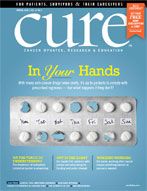Test Case: Despite Debate, PSA Testing for Prostate Cancer Can Be a Life-Saving Measure
When the USPSTF issued its recommendation against PSA testing, urologists nationwide, myself included, warned about the possible public health repercussions that could ensue. Our fears have materialized, and much sooner than anticipated.
PHOTO COURTESY OF DEEPAK KAPOOR

Deepak A. Kapoor, a board-certified urologist, is chairman and CEO of Integrated Medical Professionals in Melville, N.Y., and clinical associate professor of urology at the Icahn School of Medicine at Mount Sinai.
The Nation's approach to prostate cancer is sometimes difficult to understand for those of us who treat this disease. For virtually every other human disease the focus is on early detection and treatment, but for prostate cancer, it seems there is an effort to convince Americans that this is no longer necessary. Most notably, the U.S. Preventive Services Task Force (USPSTF) has recommended against screening for prostate cancer, a position adopted by other national organizations and, more recently, by some insurance carriers.
The reality is much different and, unfortunately, much more frightening. Prostate cancer continues to be the most commonly diagnosed solid tumor in men — it’s estimated that around 221,000 men will be diagnosed with the disease this year. Although it’s true that prostate cancer may be slow-growing in some cases, it remains the second leading cause of cancer death in American men; nearly 28,000 will lose their lives to the disease this year alone.
So what’s causing the confusion? As men age, the prostate gland undergoes cellular changes, sometimes including the development of cancer cells. Autopsy studies have revealed the presence of asymptomatic cancer cells in as many as 80 percent of 80-year-old men, yet most of these men die of causes other than prostate cancer. Historically, we’ve had difficulty distinguishing men who are going to die with prostate cancer from those who are going to die of prostate cancer.
Let’s start by understanding how we detect prostate cancer. In addition to a prostate exam, screening involves a blood test for prostate-specific antigen (PSA), a protein that tends to be elevated in those who have prostate cancer. However, while the PSA is prostate specific, it is not prostate cancer specific; if levels are high, biopsies are needed to help confirm whether the disease is present. This is at the heart of the problem — while the PSA test itself is not dangerous, the USPSTF argues that, for the population overall, the risks of diagnosing and treating prostate cancer outweigh any potential survival benefits that result from early detection.
Is there any truth to this? As physicians, we weigh the risks of therapy against the risks of no treatment, but as prostate cancer therapies have become safer, less invasive and more effective, it has become easier to recommend treatment — particularly since, until recently, we lacked precise tools to specifically predict the aggressiveness of the cancer. This uncertainty may also cause patients to overlook untoward effects from treatment rather than face an uncertain probability of death from disease. As a consequence, some patients who may have been able to safely defer treatment have been treated immediately.
The good news is that we’ve made great strides in the past five years in our ability to predict the behavior of prostate cancer; improved staging techniques, along with genetic and molecular markers, now help determine which patients should receive immediate therapy and for whom intervention may be deferred.
The USPSTF’s recommendation that no one should be screened for prostate cancer — based on reviews by a committee that did not include a single physician with experience treating the disease — failed to appropriately consider the historically proven benefit of routine PSA screening. Since PSA testing was approved in 1986 by the U.S. Food and Drug Administration, the 10-year survival rate for prostate cancer in the U.S. has increased from less than 70 percent to over 99 percent. Our experience here is similar to that in other countries. The largest study ever performed on the subject, the European Randomised Study of Screening for Prostate Cancer, found that, after 13 years of follow-up, men screened for prostate cancer had a 21 percent decline in mortality when compared to unscreened men.
When the USPSTF issued its recommendation against PSA testing, urologists nationwide, myself included, warned about the possible public health repercussions that could ensue. Our fears have materialized, and much sooner than anticipated. Researchers just released findings showing that in the two years since the recommendation was issued, there has been a significant migration at time of diagnosis toward more advanced, higher-grade cancer. As these cancers are less treatable than those detected early, the study concluded that prostate cancer deaths could increase by 5 percent annually — the first increase in prostate cancer death rates in over 20 years.
Given this evidence supporting the value of PSA screening, I recommend that men talk to their doctors about their particular risk factors for prostate cancer and develop customized early detection programs that are appropriate in the context of their overall health and wellness. The following represents a common-sense approach to prostate cancer testing, based on internationally accepted consensus guidelines:
- A baseline serum PSA level should be obtained in men in their 40s who have made an informed decision to pursue early prostate cancer detection.
- Intervals for prostate cancer screening should: be adapted to a patient’s baseline PSA; take into account an individual’s prostate cancer risk factors (such as family history of prostate cancer and African-American descent); and allow for the potentially short preclinical timeline of aggressive cancers.
- PSA screening should be offered to men with a life expectancy of 10 or more years, without a predetermined upper limit of age.
Most importantly, patients need to understand that undergoing prostate cancer screening does not obligate them to undergo further diagnostic testing or treatment, even if abnormalities are found. It simply provides a piece of information that assists in making sound health care decisions — which, ultimately, could prove life-saving.
